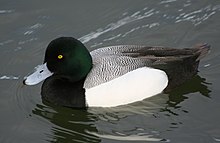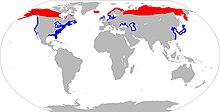Greater scaup
| Greater scaup Temporal range:
| |
|---|---|

| |
| Adult male in California | |

| |
| Adult female in Ontario | |
| Scientific classification | |
| Domain: | Eukaryota |
| Kingdom: | Animalia |
| Phylum: | Chordata |
| Class: | Aves |
| Order: | Anseriformes |
| Family: | Anatidae |
| Genus: | Aythya |
| Species: | A. marila
|
| Binomial name | |
| Aythya marila (Linnaeus, 1761)
| |
| Subspecies | |
|
A. m. marila (Linnaeus, 1761) | |

| |
| Range of Aythya marila | |
| Synonyms | |
|
Anas marila Linnaeus, 1761 | |
The greater scaup (Aythya marila), just scaup in Europe or, colloquially, "bluebill" in North America,[3] is a mid-sized diving duck, larger than the closely related lesser scaup. It spends the summer months breeding in Alaska, northern Canada, Siberia, and the northernmost reaches of Europe. During the winter, it migrates south to the coasts of North America, Europe, and Japan.
Drake greater scaup are larger and have more rounded heads than the females; they have a bright blue bill and yellow eyes. Their heads are dark, with a green gloss; the breast is black, the belly white and the wing shows a white stripe. The females are mostly brown, again with white on the wing. They have dull blue bills and white on the face.
Greater scaup nest near water, typically on islands in northern lakes or on floating mats of vegetation. They begin breeding at age two, but start building nests in the first year. The drakes have a complex courtship, which takes place on the return migration to the summer breeding grounds and concludes with the formation of monogamous pairs. Females lay a clutch of six to nine olive-buff-colored eggs. The eggs hatch in 24 to 28 days. The down-covered ducklings are able to follow their mother in her search for food immediately after hatching.
Greater scaup eat aquatic
Taxonomy
The greater scaup was
The genus name Aythya is derived from the Ancient Greek aithuia which refers to a seabird mentioned by Aristotle and others and is thought to refer to a duck, auklet or other seabird. The species name marila is from the Greek word for charcoal embers or coal dust.[8]
At least two subspecies of Greater scaup are recognized. The nominate A. m. marila is found from northern Europe to east Siberia, west of the
A

Description
The adult greater scaup is 39–56 cm (15–22 in) long with a 71–84 cm (28–33 in) wingspan and a body mass of 726–1,360 g (1.601–2.998 lb). It has a blue bill and yellow eyes and is 20% heavier and 10% longer than the closely related lesser scaup.
The adult female has a brown body and head, with white wing markings similar to those of the male but slightly duller. It has a white band and brown oval shaped patches at the base of the bill, which is a slightly duller shade of blue than the drake's.[15] Juvenile greater scaup look similar to adult females. The greater scaup drake's eclipse plumage looks similar to its breeding plumage, except the pale parts of the plumage are a buffy gray.[16]
Distinguishing greater from lesser scaups can be difficult in the field. The head of the greater tends to be more rounded, and the white wing stripe is more extensive. The bill is also tends to be larger and wider, often with a large black nail at the tip. The North American subspecies nearctica typically has a higher forehead and reduced white on the wings, intermediate between the European marila and Lesser Scaup.[14]
Distribution and habitat
The greater scaup has a circumpolar distribution, breeding within the Arctic Circle both in the Old World (the
In Europe, the greater scaup breeds in Iceland, the northern coasts of the
In North America, the greater scaup summers in
Behaviour
Breeding

Greater scaup breed in the tundra and the
Pairs nest in close proximity to each other in large colonies, usually near water, on an island or shoreline, or on a raft of floating vegetation. The nest consists of a shallow depression made by the female and lined with her down.[14] After the female lays the eggs, the drake abandons the female[23] and goes with other drakes to a large, isolated lake to molt. These lakes can be close to the breeding grounds or miles away. The lakes chosen are used yearly by the same ducks. The optimal molting lake is fairly shallow and has an abundance of food sources and cover.[24]
The female lays six to nine olive-buff-colored eggs,[25] which she incubates for 24–28 days.[26] A larger clutch could indicate brood parasitism by other greater scaups or even ducks of other species.[27] Newly hatched chicks are covered with down and are soon able to walk, swim, and feed themselves; however, they are not able to fly until 40–45 days after hatching.[18][23] The vulnerable small chicks follow their mother, who protects them from predators.[23]
Feeding

The greater scaup dive to obtain food, which they eat on the surface.
Threats
Common predators of the greater scaup are
Although the greater scaup faces numerous threats, the most significant challenge to their survival is habitat degradation caused by a mix of human development and runoff.[31] Greater scaup, when moulting and during the winter, are threatened by escalated levels of organochloride contaminants. Oil and sewage pollution also threaten this duck. Since 80% of the greater scaup population winters in the urbanized part of the Atlantic Flyway, these ducks are subject to high levels of organic contaminates, along with increased levels of heavy metals in foods and habitat.[19]
A joint group of American and Canadian scientists researching scaup migration across the Great Lakes found that 100% of female greater scaup, and 77% of female lesser scaup, had escalated levels of
In a study of 107 scaup, they all had traces of iron, zinc, manganese, copper, lead, cadmium, cobalt and nickel in their tissue samples with varying concentrations of metals in different types of tissues. Further analysis revealed that the kidneys had the highest levels of cadmium, the liver had the highest levels of copper and manganese, the liver and the stomach had the highest levels of zinc, and the lungs and liver had the highest levels of iron.[32] There was no difference in concentration when comparing genders.
Conservation
Greater scaup are rated as a species of least concern by the IUCN Redlist.

Human interactions
Greater scaup are a popular
References
- ^ Alvarez, Rafael (1977). "A pleistocene avifauna from Jalisco, Mexico" (PDF). Contributions from the Museum of Paleontology, University of Michigan. 24 (19). University of Michigan: 214. Retrieved 9 March 2015.
- ^ . Retrieved 11 November 2021.
- ^ a b "Bluebills". Minnesota Department of Natural Resources. Archived from the original on 20 December 2013. Retrieved 3 November 2011.
- ^ Linnaeus, Carl (1761). Fauna svecica, sistens animalia sveciae regni mammalia, aves amphibia, pisces, insecta, vermes (in Latin) (2nd ed.). Stockholmiae: Sumtu & Literis Direct. Laurentii Salvii. p. 39.
- ^ Mayr, Ernst; Cottrell, G. William, eds. (1979). Check-List of Birds of the World. Vol. 1 (2nd ed.). Cambridge, Massachusetts: Museum of Comparative Zoology. p. 486.
- ^ Boie, Friedrich (1822). Tagebuch gehalten auf einer Reise durch Norwegen im Jahre 1817 (in German). Schleswig. pp. 308, 351.
- Rasmussen, Pamela, eds. (2020). "Screamers, ducks, geese, swans". IOC World Bird List Version 10.1. International Ornithologists' Union. Retrieved 23 March 2020.
- ISBN 978-1-4081-2501-4.
- ISBN 978-0691162669.
- S2CID 250043960
- ^ Banks, R.C. (1986). "Subspecies of the Greater Scaup and their names" (PDF). Wilson Bulletin. 98 (3): 433–444.
- ISBN 978-0-19-861271-1.
- JSTOR 4088937.
- ^ a b c d e "Greater Scaup". Bird Web. Seattle Audubon Society. Retrieved 26 October 2011.
- ^ a b "Greater Scaup". Ducks Unlimited. Retrieved 1 November 2011.
- ^ "Greater Scaup". enature.com. Archived from the original on 12 February 2012. Retrieved 11 December 2011.
- ^ a b c "Greater Scaup Aythya marila". Bird Life International. Retrieved 9 March 2015.
- ^ a b c d e "Greater Scaup". Avibirds European birdguide online. Retrieved 8 November 2011.
- ^ a b "Greater Scaup". The Birds of North America. Cornell Lab of Ornithology. Retrieved 2 January 2011.
- ISBN 978-91-46-17633-6.
- ISBN 978-91-34-51940-4.
- ^ a b Mayntz, Melissa. "Greater Scaup". About.com. Archived from the original on 10 March 2010. Retrieved 20 August 2011.
- ^ a b c d "Greater Scaup". Utah Department of Natural Resources. Retrieved 8 November 2011.
- ^ "Greater Scaup". All About Birds. Cornell Lab of Ornithology. Retrieved 18 December 2011.
- ^ "Greater Scaup". National Audubon Society, Inc. Archived from the original on 25 April 2012. Retrieved 27 November 2011.
- ^ "Greater Scaup". Ohio Department of Natural Resources. Retrieved 9 March 2015.
- doi:10.14430/arctic801. Archived from the originalon 2012-04-25.
- ^ Longley, William H. (1948). "Greater scaup eating frogs" (PDF). The Auk. 66 (2): 200.
- ^ "Greater Scaup". Audubon. National Audubon Society. Archived from the original on 11 November 2010. Retrieved 26 October 2011.
- ^ "Greater Scaup". United States Fauna. Archived from the original on 21 October 2013. Retrieved 2 November 2011.
- ^ "Greater Scaup". National Biological Information Infrastructure. Archived from the original on 9 December 2011. Retrieved 8 November 2011.
- .
- ^ "Waterfowl Hunting Management in North America". Scaup Population Estimates. U.S. Fish and Wildlife Service in collaboration with flyway and state waterfowl managers. 29 June 2010. Retrieved 4 November 2011.
- ^ "Banding and Marking Programs". U.S. Fish and Wildlife Service. Retrieved 28 November 2011.
- ^ a b "European Union Management Plan" (PDF). EU. European Union. Retrieved 2 November 2011.
- ^ "Greater Scaup". Discover the Outdoors. Retrieved 19 November 2011.
Further reading
- Collinson, Martin (June 2006). "Splitting headaches? Recent taxonomic changes affecting the British and Western Palaearctic lists". British Birds. 99: 306–323.
- Madge, Steve; Burn, Hilary (1988). Wildfowl: An Identification Guide to the Ducks, Geese and Swans of the World. London: Christopher Helm. ISBN 978-0-7470-2201-5.
External links
- Greater Scaup Species Account – Cornell Lab of Ornithology
- Greater Scaup - Aythya marila - USGS Patuxent Bird Identification InfoCenter
- "Greater scaup media". Internet Bird Collection.
- Greater scaup photo gallery at VIREO (Drexel University)


